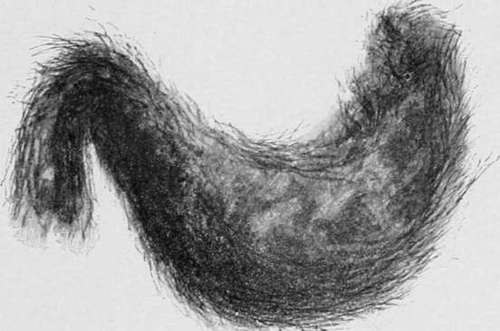Chapter V. Concretions In The Stomach [Hair-Balls-Bezoars-Gastroliths]
Description
This section is from the book "Cancer And Other Tumours Of The Stomach", by Samuel Fenwick. Also available from Amazon: Cancer and other tumours of the stomach.
Chapter V. Concretions In The Stomach [Hair-Balls-Bezoars-Gastroliths]
Ceetain concretions are apt to form in the stomach, and to give rise to severe gastric symptoms attended by an abdominal tumour. As a rule they consist of hair, cotton, wool, tow or string, but occasionally they are composed entirely of vegetable matter, fibrous roots, or of resinous material.
(1) Hair-balls of sufficient size to attract attention are very rare, and we have beena ble to collect only twenty-four cases, the first of which was recorded by Baudamant in 1777.1 When comparatively small the mass is round or oval in shape, and occupies the pyloric region, where it acts like a ball-valve; but as it increases in size it becomes moulded by the gastric contractions, until it forms a solid cast of the organ, and may even extend upwards into the oesophagus (Best) or through the pylorus into the jejunum (Gull, Pollock). It is smooth on the surface, compact and heavy, and consists of a vast number of hairs, varying from two to twelve inches in length, which are closely interwoven and agglutinated by mucus and food debris. In Gull's case the component hairs were of three colours, and could be recognised as belonging to the patient and her two children. Sometimes the hair is mixed with cotton, thread, or pieces of string. The largest concretion on record weighed 41b. 7 oz. (Eussell), and the smallest 5| oz. The habit of swallowing hair is not confined to the human subject, but is met with in the lower animals, and especially in cats, the Angora breed of which are said frequently to die from gastric concretions, owing to their habit of eating their fur when it is shed at certain periods of the year (Chepmell). Lunatics usually prefer harder substances, such as nails and crockery, but in a case recorded by Quain fatal perforation of the stomach was caused by a ball of cocoanut fibre weighing four pounds.
1 Schonborn states that in the year 1883 only seven cases had been recorded. He appears, however, to have overlooked English and American literature.
(2) Concretions composed of vegetable matter are occasionally found in the stomachs of persons who have consumed large quantities of fibrous roots or of other substances, owing to a perverted appetite or from a superstitious belief in their medicinal properties. Thus, in Kooyker's case a mass of starch and vegetable fibre weighing twenty-nine ounces was found in the stomach after death ; while in that recorded by Schreiber the organ was completely filled by a mass of roots (Schwarzwurzel).
(3) Stones or Gastroliths are very rare, and we have been able to find only four authentic cases in the literature. They usually consist of shellac, which has been introduced into the stomach in the form of an alcoholic polish or varnish, and may be either single or multiple (Friedlander). As a rule they do not exceed three ounces in weight, but in the case related by Tidemand the mass weighed 1,500 grammes.
The local effects of the concretion consist of dilatation of the stomach with chronic inflammation and atrophy of its mucous membrane; while occasionally the organ becomes fixed by adhesions to the pancreas or abdominal wall (May). When the oesophagus or the duodenum is involved the orifices may be greatly dilated. In more than one-half of the cases death occurred from perforation of the stomach in the pyloric region, or, as in those related by Gull and Yeo, from a similar lesion of the duodenum. Hseniatemesis was responsible for the fatal termination in one instance (Eussell), and intestinal obstruction in several others (Eitchie, Friedlander). Occasionally the chronic irritation of the mass gives rise to superficial erosions, or even to papillomata (Best).

Fig. 64.-A hair-ball (about one-half natural size).
Symptoms
The fact that various foreign bodies are frequently found in the alimentary tract of lunatics has given rise to the impression that gastric concretions occur only in persons of unsound mind. This belief is not only erroneous, but has been the cause of serious mistakes in diagnosis, for more than one writer has stated that, had he been aware that sane people were liable to the complaint, he might have suspected the nature of the abdominal tumour and have saved the patient's life by a timely operation.
Continue to:
